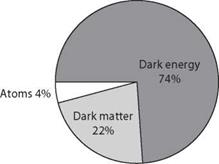Precision Cosmology
WMAP has not only put us “in tune” with the cosmos; it has refined and sharpened our view of the extraordinary event that created all matter and energy 13.8 billion years ago.
WMAP has taken quantities that were poorly known or only hinted at and turned them into well-measured cosmological param – eters.58 The temperature is measured to a precision of a thousandth of a degree. Since space can be curved according to general relativity, the universe can act as a gigantic lens. To do this vast optics experiment we look at the microwaves that have been traveling across space for billions of years. The fundamental harmonic of the microwave radiation sets the size of the “spot.” Radiation from that typical spot size travels through space and the angular size can be magnified or de-magnified depending on whether space has positive or negative curvature, which is like the universe acting as either a convex or a concave lens. WMAP has shown that the spot size doesn’t change so the universe is behaving like a smooth sheet of glass. The inference is that space is not curved; the universe is flat to a precision of 1 percent.59 This is just as expected from inflation.
WMAP has measured the mass and energy of the universe with unprecedented precision. The ratio of fundamental to first harmonic powers depends on the baryonic or normal matter content of the universe. Ordinary atoms only make up 4.6 percent of the universe, to within 0.1 percent. The strength of the second harmonic is sensitive to dark matter, and shows that dark matter is 23 percent of the universe, to within 1 percent.60 Knowing the mass and energy content of the universe, General Relativity can be used to calculate the current age. It’s 13.73 billion years with a precision of 1 percent or 120 million years, though that precision depends on assuming that space is exactly flat (which is a good assumption). These numbers have been refined and slightly altered by Planck. The cosmic “pie” has dark slices and just a sliver of visible stuff (figure 12.4).
We’ve also been able to learn about the epoch when the first stars and galaxies formed using the WMAP data. If stars formed soon enough after recombination, they would have ionized the still-diffusing gas. That would have recreated the conditions where photons bounce off electrons, as was routinely the case before recombination. This late scattering imprints polarization on the microwave radiation, analogous to sunlight being polarized when it bounces off a water surface. Polarization requires a special direction, and that can only be seen if photons travel relatively freely before interacting. Before recombination no polarization is expected. WMAP saw a polarization indicating that 20 percent of the photons were scattered by a sparse fog of ionized gas a couple of hundred million years after the big bang. This is surprising because astronomers didn’t expect the first stars to form that quickly.61
The sum of all WMAP’s improvements leaves little doubt that the universe began with a hot big bang. The model is described quite precisely and any competing idea would have to clear some very high bars of evidence to be viable. It’s extraordinary that we can know some attributes of the overall universe better than we know attributes of the Earth.
|
Figure 12.4. Observations of the microwave background radiation combined with ground-based observations determine the contents of the universe. Most of the universe is in the form of enigmatic dark matter and dark energy, with just a small component of the normal matter that comprises all stars, planets, and people (NASA/WMAP Science Team). |











